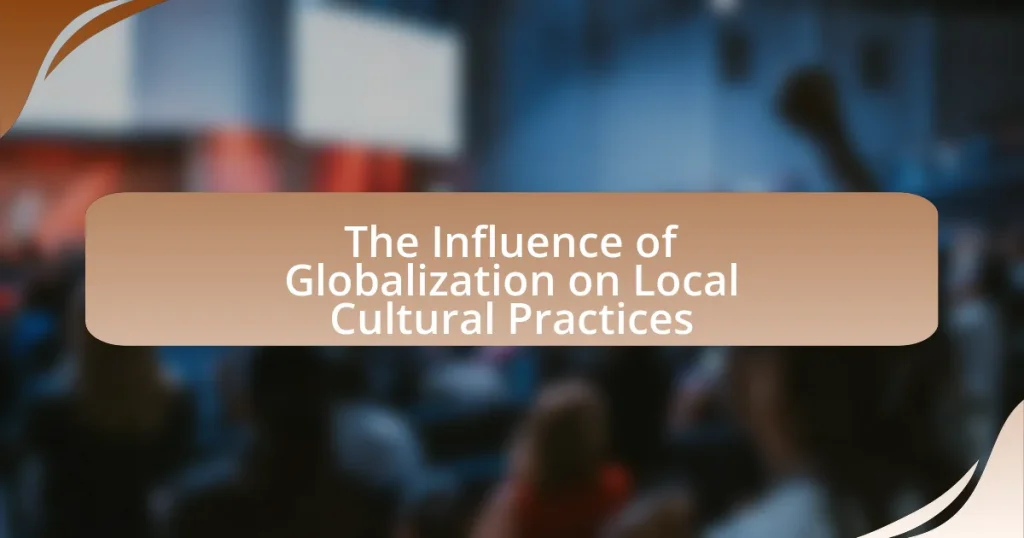The article examines the influence of globalization on local cultural practices, highlighting how the exchange of ideas, values, and traditions across borders can lead to cultural homogenization and hybridization. It discusses the impact of globalization on cultural identity, including the erosion of local languages and traditions, and the adaptation of communities in response to these changes. The role of technology, particularly the internet and social media, in facilitating cultural exchange and shaping interactions is also explored. Additionally, the article outlines strategies for cultural preservation, emphasizing the importance of education, community engagement, and support for local artisans in maintaining cultural heritage amidst globalization pressures.

What is the Influence of Globalization on Local Cultural Practices?
Globalization significantly influences local cultural practices by facilitating the exchange of ideas, values, and traditions across borders. This process often leads to the homogenization of cultures, where local customs may be overshadowed by dominant global trends, such as Western consumer culture. For instance, the proliferation of fast food chains worldwide has altered traditional dietary habits in many countries, as seen in the increased consumption of processed foods in places like India and China. Additionally, globalization can also result in cultural hybridization, where local practices adapt and merge with global influences, creating new cultural expressions. An example of this is the fusion of traditional music styles with contemporary genres, which has become prevalent in various regions, reflecting both local heritage and global trends.
How does globalization affect cultural identity?
Globalization significantly affects cultural identity by promoting the exchange and blending of cultural elements across different societies. This process often leads to the dilution of local traditions and practices as global cultural influences, such as media, fashion, and cuisine, become more dominant. For instance, the widespread popularity of Western media has led to the adoption of Western values and lifestyles in various cultures, which can overshadow indigenous customs. Research by Arjun Appadurai in “Modernity at Large” highlights how globalization creates a “disjuncture” between local cultures and global influences, resulting in hybrid identities that may lack the depth of traditional cultural practices.
What are the key elements of cultural identity impacted by globalization?
The key elements of cultural identity impacted by globalization include language, traditions, values, and social practices. Globalization facilitates the spread of dominant cultures, often leading to the erosion of local languages as seen in the decline of indigenous languages worldwide, where over 40% are at risk of disappearing. Additionally, traditional customs and rituals may be altered or replaced by global consumer culture, as evidenced by the widespread adoption of Western holidays and practices in non-Western societies. Values such as individualism may overshadow communal values, changing social dynamics and relationships within communities. These elements illustrate how globalization can significantly reshape cultural identity, often prioritizing global norms over local heritage.
How do local communities respond to changes in cultural identity?
Local communities respond to changes in cultural identity by adapting their traditions, practices, and social structures to incorporate new influences while striving to maintain their unique cultural heritage. This adaptation often manifests in the blending of local customs with global trends, resulting in hybrid cultural expressions. For example, in many urban areas, traditional festivals may incorporate contemporary music and fashion, reflecting both local and global influences. Research indicates that communities actively negotiate their cultural identity through participation in cultural exchanges, which can enhance social cohesion and resilience against cultural homogenization. Studies, such as those by Hannerz (1996) in “Transnational Connections,” highlight how local communities navigate globalization by selectively adopting elements that resonate with their identity while resisting those that threaten their cultural integrity.
What role does technology play in the globalization of culture?
Technology serves as a catalyst for the globalization of culture by facilitating instant communication and the rapid dissemination of information across the globe. The internet, social media platforms, and mobile devices enable individuals from diverse cultural backgrounds to share their traditions, values, and practices with a wider audience, thus promoting cultural exchange. For instance, according to a report by the Pew Research Center, 72% of adults in the U.S. use social media, which allows for the sharing of cultural content and experiences, leading to a blending of cultural identities. This interconnectedness fosters a global cultural landscape where local practices can influence and be influenced by global trends, demonstrating technology’s pivotal role in shaping cultural globalization.
How has the internet changed the way cultures interact?
The internet has fundamentally transformed cultural interactions by enabling instantaneous communication and access to diverse cultural content across the globe. This connectivity allows individuals from different cultural backgrounds to share ideas, traditions, and practices in real-time, fostering cross-cultural exchanges that were previously limited by geographical barriers. For instance, social media platforms facilitate the sharing of cultural expressions, such as music, art, and cuisine, leading to the blending of cultural elements and the emergence of hybrid cultural forms. According to a 2020 report by the Pew Research Center, 72% of adults in the U.S. use social media, which serves as a primary avenue for cultural interaction and exchange. This widespread use illustrates how the internet has democratized access to cultural resources, allowing for greater visibility and appreciation of diverse cultures.
What are the implications of social media on local cultural practices?
Social media significantly influences local cultural practices by facilitating the rapid exchange of cultural ideas and norms, often leading to cultural homogenization. This platform allows users to share and access diverse cultural content, which can dilute traditional practices as global trends gain prominence. For instance, a study by the Pew Research Center found that 72% of adults in the U.S. use social media, which exposes them to a variety of cultural expressions that may overshadow local customs. Additionally, social media can create a space for cultural appropriation, where elements of local cultures are adopted without understanding their significance, further impacting the authenticity of those practices.
Why is understanding the influence of globalization on local cultures important?
Understanding the influence of globalization on local cultures is important because it helps to identify how global interconnectedness affects cultural identity, practices, and values. Globalization can lead to cultural homogenization, where local traditions may diminish or transform under the pressure of dominant global cultures, impacting community cohesion and heritage preservation. For instance, the spread of Western media and consumer products has altered traditional lifestyles in various regions, as seen in the adoption of fast food and entertainment that overshadow local cuisines and customs. Recognizing these dynamics enables communities to navigate the challenges posed by globalization while fostering cultural resilience and promoting diversity.
What are the potential benefits of cultural exchange?
Cultural exchange offers numerous benefits, including enhanced mutual understanding, increased creativity, and economic growth. Enhanced mutual understanding arises as individuals from different backgrounds share their traditions, values, and perspectives, fostering tolerance and reducing stereotypes. Increased creativity is evident in the arts, where diverse influences lead to innovative expressions and collaborations. Economic growth can be observed through tourism and trade, as cultural exchange attracts visitors and promotes local products, contributing to community development. For instance, UNESCO reports that cultural tourism can significantly boost local economies, highlighting the tangible benefits of cultural interactions.
How can awareness of cultural influences promote tolerance and understanding?
Awareness of cultural influences can promote tolerance and understanding by fostering empathy and reducing stereotypes. When individuals recognize the diverse backgrounds and experiences that shape different cultures, they are more likely to appreciate the values and beliefs of others. Research indicates that exposure to various cultural perspectives can lead to increased open-mindedness; for instance, a study published in the Journal of Cross-Cultural Psychology found that individuals who engage with diverse cultures exhibit greater levels of tolerance and acceptance. This understanding helps to bridge gaps between communities, facilitating peaceful coexistence and collaboration in a globalized world.

What are the specific impacts of globalization on local cultural practices?
Globalization significantly impacts local cultural practices by promoting cultural homogenization, leading to the erosion of unique traditions and identities. As global media and multinational corporations disseminate dominant cultural narratives, local customs often become overshadowed. For instance, the widespread availability of Western entertainment and consumer products can diminish the relevance of indigenous art forms and traditional practices, as seen in many communities where local festivals are replaced by globalized events like Halloween or Christmas. Additionally, the influx of foreign ideas and lifestyles can create a hybrid culture, where local practices are modified to incorporate global influences, resulting in a blend that may dilute original cultural expressions. This phenomenon is evident in urban areas worldwide, where local cuisines adapt to include international flavors, altering traditional recipes.
How does globalization lead to cultural homogenization?
Globalization leads to cultural homogenization by facilitating the widespread exchange of ideas, values, and practices across borders, resulting in a convergence of cultures. This process is driven by the proliferation of global media, multinational corporations, and the internet, which promote dominant cultural narratives, often overshadowing local traditions. For instance, the global popularity of Western entertainment, such as Hollywood films and pop music, has significantly influenced cultural expressions worldwide, leading to similar lifestyles and consumer behaviors. Research indicates that as countries engage more with global markets, local customs and languages may decline, further contributing to a uniform cultural landscape.
What examples illustrate cultural homogenization in various regions?
Cultural homogenization is illustrated by the global spread of fast food chains, particularly McDonald’s, which has established a presence in over 100 countries, often leading to the decline of local cuisines. In Asia, the adoption of Western fashion trends has resulted in a shift away from traditional attire, as seen in countries like Japan and South Korea, where Western styles dominate urban centers. Additionally, the proliferation of social media platforms like Facebook and Instagram has created a shared global culture, diminishing regional differences in communication and social interaction. These examples demonstrate how globalization fosters a convergence of cultural practices across diverse regions.
How do local traditions adapt or disappear due to globalization?
Local traditions adapt or disappear due to globalization primarily through the processes of cultural homogenization and the integration of global influences. As global communication and trade increase, local customs often blend with or are replaced by dominant global cultures, leading to a dilution of unique practices. For instance, the rise of fast food chains has transformed traditional eating habits in many countries, resulting in a shift away from local cuisines. According to a study by the United Nations Educational, Scientific and Cultural Organization (UNESCO), over 50% of the world’s languages are at risk of disappearing, which reflects the broader trend of local cultures being overshadowed by more widely spoken languages and cultures. This evidence illustrates how globalization can lead to the erosion of local traditions, as communities may adopt global practices for economic or social reasons, ultimately diminishing their cultural heritage.
What are the effects of globalization on traditional art forms?
Globalization significantly impacts traditional art forms by facilitating the exchange of cultural ideas and practices, often leading to both preservation and transformation. Traditional art forms may gain wider recognition and appreciation through global platforms, which can enhance their visibility and economic viability. However, this exposure can also result in the dilution of cultural authenticity as artists may adapt their work to meet global market demands. For instance, the rise of digital platforms has allowed traditional artisans to reach international audiences, yet it often pressures them to modify their styles to align with contemporary trends. This dual effect illustrates how globalization can simultaneously support and challenge the integrity of traditional art forms.
How do global markets influence local artisans and their crafts?
Global markets significantly influence local artisans and their crafts by expanding their reach and altering demand patterns. As global consumers seek unique, handcrafted items, local artisans can access larger markets through online platforms, increasing their sales potential. For instance, a study by the International Trade Centre found that e-commerce has enabled artisans in developing countries to sell their products internationally, leading to a 30% increase in income for some. Additionally, exposure to global trends can inspire local artisans to innovate and adapt their crafts, ensuring they remain competitive while preserving cultural heritage.
What challenges do traditional artists face in a globalized world?
Traditional artists face significant challenges in a globalized world, primarily due to the overwhelming influence of mass-produced art and digital media. This saturation of global art markets often diminishes the visibility and value of traditional art forms, making it difficult for artists to sustain their practices. Additionally, traditional artists struggle with cultural appropriation, where elements of their art are commodified and misrepresented by others without proper acknowledgment or respect for their origins. Economic pressures also arise, as global competition can lead to reduced prices for traditional artworks, undermining the livelihoods of artists who rely on their craft. These challenges highlight the need for greater support and recognition of traditional art within the global cultural landscape.
How does globalization impact language and communication?
Globalization significantly impacts language and communication by promoting the spread of dominant languages, such as English, while simultaneously leading to the decline of less widely spoken languages. This phenomenon occurs as global trade, technology, and media facilitate cross-cultural interactions, resulting in a preference for languages that enhance economic and social opportunities. For instance, according to a report by the Linguistic Society of America, over 7,000 languages are spoken worldwide, yet many are at risk of extinction due to the increasing prevalence of global languages in education and media. This shift not only affects linguistic diversity but also alters communication styles, as individuals adapt to a more homogenized linguistic landscape influenced by global norms and practices.
What languages are at risk due to the dominance of global languages?
Languages at risk due to the dominance of global languages include indigenous languages, minority languages, and regional dialects. For instance, languages such as Navajo, Gaelic, and many African languages face extinction as speakers shift to more dominant languages like English, Spanish, and Mandarin. According to UNESCO, approximately 40% of the world’s languages are endangered, with many losing speakers as globalization promotes the use of a few global languages for economic and social mobility. This trend threatens linguistic diversity and cultural heritage, as communities abandon their native languages in favor of those that offer greater opportunities.
How does language loss affect cultural heritage?
Language loss significantly undermines cultural heritage by eroding the transmission of traditional knowledge, practices, and values inherent in that language. When a language becomes extinct, the unique worldview and cultural identity it encapsulates are often lost, as language serves as a vessel for cultural expressions, rituals, and historical narratives. For instance, the loss of indigenous languages has been linked to the disappearance of traditional ecological knowledge, which is crucial for sustainable practices and biodiversity conservation. According to a study published in the journal “Language Documentation & Conservation,” over 90% of the world’s languages are projected to become extinct by the end of the century, leading to irreversible cultural losses. This illustrates the direct correlation between language vitality and the preservation of cultural heritage, emphasizing that language is not merely a communication tool but a fundamental component of cultural identity.

What strategies can local cultures employ to preserve their practices amidst globalization?
Local cultures can employ several strategies to preserve their practices amidst globalization, including the promotion of cultural education, community engagement, and the use of technology. Cultural education initiatives, such as workshops and classes, can teach younger generations about traditional practices, ensuring knowledge transfer. Community engagement fosters a sense of identity and belonging, encouraging locals to participate in cultural events and rituals. Additionally, technology can be leveraged to document and share cultural practices through social media and online platforms, reaching wider audiences while maintaining authenticity. For instance, UNESCO recognizes the importance of safeguarding intangible cultural heritage, highlighting that communities actively involved in preserving their traditions can resist the homogenizing effects of globalization.
How can communities promote cultural heritage in a globalized world?
Communities can promote cultural heritage in a globalized world by actively engaging in cultural preservation initiatives and fostering local traditions. For instance, organizing cultural festivals that showcase traditional music, dance, and crafts allows communities to celebrate and share their unique heritage with both locals and tourists. Research indicates that such events can increase community pride and awareness, as seen in the UNESCO-recognized Intangible Cultural Heritage practices, which emphasize the importance of local customs in a global context. Additionally, educational programs in schools that incorporate local history and traditions can help instill a sense of identity and continuity among younger generations, ensuring that cultural practices are passed down and remain relevant despite globalization pressures.
What role do education and awareness play in cultural preservation?
Education and awareness are crucial for cultural preservation as they empower individuals and communities to understand, appreciate, and actively engage with their cultural heritage. By providing knowledge about traditions, languages, and historical contexts, education fosters a sense of identity and belonging, which is essential for maintaining cultural practices. For instance, UNESCO emphasizes that educational programs that include local history and cultural practices can significantly enhance community involvement in preservation efforts. Furthermore, awareness campaigns can highlight the importance of cultural diversity, encouraging respect and protection of various cultural expressions in the face of globalization. This dual approach of education and awareness not only safeguards cultural heritage but also promotes its transmission to future generations, ensuring its continuity.
How can local governments support cultural initiatives?
Local governments can support cultural initiatives by providing funding, resources, and infrastructure to promote local arts and heritage. For instance, they can allocate budgetary resources specifically for cultural programs, which can enhance community engagement and preserve local traditions. According to the National Endowment for the Arts, local arts agencies that receive government funding report increased participation in cultural activities, demonstrating the positive impact of financial support on community involvement. Additionally, local governments can facilitate partnerships between cultural organizations and businesses, fostering a collaborative environment that encourages cultural expression and innovation.
What are some successful examples of cultural preservation?
Successful examples of cultural preservation include the revitalization of the Hawaiian language and the preservation of traditional crafts in Japan. The Hawaiian language, once nearly extinct, has seen a resurgence through educational programs and immersion schools, with over 25,000 speakers reported in recent years. In Japan, the practice of Kintsugi, the art of repairing broken pottery with lacquer mixed with powdered gold, has been preserved through workshops and cultural festivals, ensuring that this traditional craft remains a vital part of Japanese heritage. These initiatives demonstrate effective strategies for maintaining cultural identity in the face of globalization.
How have certain communities successfully maintained their cultural practices?
Certain communities have successfully maintained their cultural practices through the preservation of language, traditional ceremonies, and community engagement. For instance, Indigenous groups in North America actively teach their languages to younger generations, ensuring linguistic continuity and cultural identity. Additionally, many communities organize annual festivals that celebrate their heritage, such as the Powwow, which reinforces cultural ties and attracts participation from both members and outsiders. Research indicates that these practices not only foster a sense of belonging but also promote cultural resilience against the pressures of globalization, as seen in the work of anthropologist Barbara Tedlock, who highlights the importance of ritual in sustaining cultural identity.
What lessons can be learned from these examples for other cultures?
Other cultures can learn the importance of adaptability and resilience from examples of globalization’s impact on local cultural practices. For instance, cultures that have successfully integrated global influences while preserving their unique traditions demonstrate that it is possible to embrace change without losing identity. The Japanese culture, which has incorporated Western elements into its fashion and technology while maintaining traditional practices like tea ceremonies, exemplifies this balance. This adaptability fosters innovation and cultural exchange, allowing for a richer, more diverse cultural landscape.
What practical steps can individuals take to support local cultures?
Individuals can support local cultures by actively engaging in and promoting local traditions, arts, and businesses. This can be achieved by attending cultural events, such as festivals and workshops, which help preserve and celebrate local heritage. Supporting local artisans and purchasing handmade goods directly contributes to the economic sustainability of cultural practices. Additionally, individuals can volunteer with local cultural organizations, which often rely on community support to thrive. Research indicates that communities with strong local cultural engagement experience enhanced social cohesion and economic resilience, demonstrating the positive impact of individual actions on cultural preservation.
How can consumers make informed choices that benefit local artisans?
Consumers can make informed choices that benefit local artisans by prioritizing the purchase of handmade goods from local markets and supporting businesses that emphasize ethical sourcing. By actively seeking out local artisans through community events, farmers’ markets, and online platforms dedicated to local crafts, consumers can directly contribute to the economic sustainability of their communities. Research indicates that supporting local artisans not only boosts local economies but also preserves cultural heritage, as artisans often incorporate traditional techniques and materials into their work. For example, a study by the American Craft Council highlights that local artisan markets can increase community engagement and foster a sense of identity, demonstrating the positive impact of consumer choices on local cultural practices.
What are the best practices for engaging with and respecting local cultures?
The best practices for engaging with and respecting local cultures include active listening, cultural education, and community involvement. Active listening allows individuals to understand local perspectives and values, fostering mutual respect. Cultural education involves learning about the history, traditions, and social norms of the community, which can prevent misunderstandings and promote appreciation. Community involvement encourages collaboration with local leaders and residents, ensuring that initiatives are culturally sensitive and beneficial. These practices are supported by studies indicating that respectful engagement leads to more sustainable and positive outcomes in cultural interactions, as seen in various community development projects worldwide.










